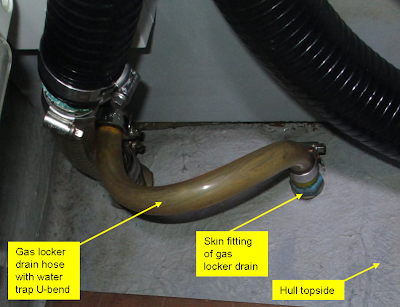Thankfully I don't come across this defect very often. It is probably something that many owners would never notice as everything looks as though it is in good order. Having said this, the hose in this photo of a gas locker drain should be of the reinforced type. Also, two hose clips should be used if the skin fitting allows this.

Gas Locker Drain Hose with Water Trap in U-bend
It isn't entirely clear from the photograph, but the gas locker drain hose from the boat's gas locker has a bend in it that can trap water. If water were to enter the locker, it would find its way into the hose where a small amount would be trapped. Similarly, when the boat is healed over on a close-haul, seawater could easily enter this drain. Until the water is able to evaporate, the locker drain will effectively be blocked. This would prevent any leaked gas from escaping harmlessly overboard. Cooking gas or LPG is a very 'searching' gas and will seep through gaps that might normally be airtight. On this vessel, it would have entered the aft heads and then into the bilge, with potentially devastating consequences.
This simple but important defect was discovered on a standard Insurance Survey on a 33' sailing yacht. Owners are usually reluctant to have these surveys done as it is often considered that the report is purely for the benefit of the Insurance Company. The above example clearly shows that the vessel's owner can gain significantly from having a thorough survey performed on their craft, even if they think that they know their boat inside-out.


48 Responses